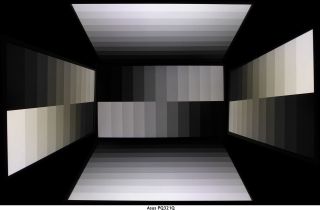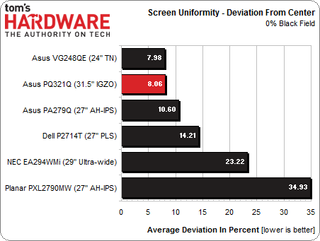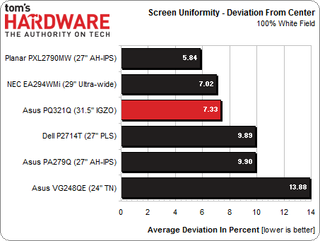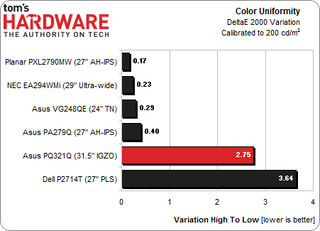Asus PQ321Q 4K Monitor Review: Top-Shelf Ultra HD For $3500
We recently got our hands on Asus’ highest-end Ultra HD-capable screen. The PQ321Q offers a native resolution of 3840x2160; and those 8.3 million pixels don’t come cheap. Our real-world and lab testing will tell you if this 4K display is worth $3500.
Results: Viewing Angles And Uniformity

Each flavor of LCD technology brings a different off-axis viewing experience. Because the emitted light is polarized, there will always be some variation in either brightness, color, or both whether you're talking about TN, IPS, or in this case, IGZO. The type of backlight also affects the result.
Asus' PQ321Q demonstrates excellent performance in the vertical plane, while the horizontal shows a slight shift towards green. Luminance is preserved very well and detail holds up beautifully. We can see the darkest steps in all of the patterns without difficulty.
Screen Uniformity: Luminance
To measure screen uniformity, zero- and 100-percent full-field patterns are used, and nine points are sampled. In a change from previous reviews, we’re now comparing the results to other monitors we’ve measured. First, we establish a baseline measurement at the center of each screen. Then the surrounding eight points are measured and their values expressed as a percentage of the baseline, either above or below. This number gets averaged. It is important to remember that we only test the review sample each vendor sends us. Other examples of the same monitor can measure differently in this metric.
First up is black field uniformity.

We're shown yet another excellent result. We can’t see the variations reported by our meter. Looking at the individual measurements, the hot spots occur in the upper-left and lower-right portions of the screen. Increasingly, we're finding 10 percent to be a good standard by which to judge screen uniformity. Beyond that and you’ll likely see the hot spots; below 10, you won’t.
Here’s the white field measurement.

The PQ321Q turns in another excellent result. There are no visible variations in brightness anywhere on the screen. By the numbers, the center is actually brighter than the surrounding areas, except for bottom-center, which is the brightest of all. That's all according to our meter. Visually, it’s perfect.
Stay On the Cutting Edge: Get the Tom's Hardware Newsletter
Get Tom's Hardware's best news and in-depth reviews, straight to your inbox.
Screen Uniformity: Color
To measure color uniformity, we display an 80-percent white field and measure the Delta E error of the same nine points on the screen. Then we subtract the lowest value from the highest to arrive at the result. A smaller number means a display is more uniform. Any value below three indicates a variation that is invisible to the naked eye.

Even though our measured result is nearly as high as Dell's P2714T, where we could just see the color shifts, we can’t see any white balance differences on the PQ321Q. The greatest error is in the top left at 3.04 Delta E. This barely just cracks the visibility point.
Current page: Results: Viewing Angles And Uniformity
Prev Page Results: Color Gamut And Performance Next Page Results: Pixel Response And Input Lag
Christian Eberle is a Contributing Editor for Tom's Hardware US. He's a veteran reviewer of A/V equipment, specializing in monitors. Christian began his obsession with tech when he built his first PC in 1991, a 286 running DOS 3.0 at a blazing 12MHz. In 2006, he undertook training from the Imaging Science Foundation in video calibration and testing and thus started a passion for precise imaging that persists to this day. He is also a professional musician with a degree from the New England Conservatory as a classical bassoonist which he used to good effect as a performer with the West Point Army Band from 1987 to 2013. He enjoys watching movies and listening to high-end audio in his custom-built home theater and can be seen riding trails near his home on a race-ready ICE VTX recumbent trike. Christian enjoys the endless summer in Florida where he lives with his wife and Chihuahua and plays with orchestras around the state.
-
cynic77 "We’re sure it’s only a matter of time before an Ultra HD panel becomes available in wide-gamut form."That time is now. The Dell 24" UP2414Q and 32" UP3214Q are Ultra HD monitors that cover 100% sRGB and 99% AdobeRBG. This Asus you've reviewed has already been outclassed.Reply -
cynic77 "We’re sure it’s only a matter of time before an Ultra HD panel becomes available in wide-gamut form."That time is now. The Dell 24" UP2414Q and 32" UP3214Q are Ultra HD monitors that cover 100% sRGB and 99% AdobeRBG. This Asus you've reviewed has already been outclassed.Reply -
cats_Paw Dat Price...Good thing is you need a crazy GPU to use that resolution anyway so by the time the 4k Monitors and tvs drop down in price we might have gpus that manage them in the upper midrange of the GPU segment.Reply -
Shneiky In the last chapter of the article, last paragraph:" crop of TN-based panels were announced at CES for sub-$1000 prices, and as those become available to test, you can be we'll review them. "Shouldn't that "be" be "bet"?Reply -
lockhrt999 If they are putting that much resolution on this screen then why not make it 3D too (polarized)? I think it's perfectly doable and won't exceed budget.I'm talking from professional point of view. I bored of using anaglyph 3D for content creation.Reply -
panzerknacker For me this is just a gimmick that can't be taken seriously. The way they had to logically divide the screen in 2 because there are no scalars yet simply screams 'niche product that you pay way too much for only to be the first person on earth using it'. Also for gaming this screen is completely useless to me with a input lag of 80ms, you take this to a LAN party and get crapped upon by those using a $100 tn panel. In the end I think this screen is a step in the right direction but for me personally they could rather revert to producing crt's again.Reply -
zodiacfml Good job but too pricey. The backlight used is for cheap TN screens. There still is no single port/cable in the market. The cutting edge is too inconvenient.Reply
Most Popular

